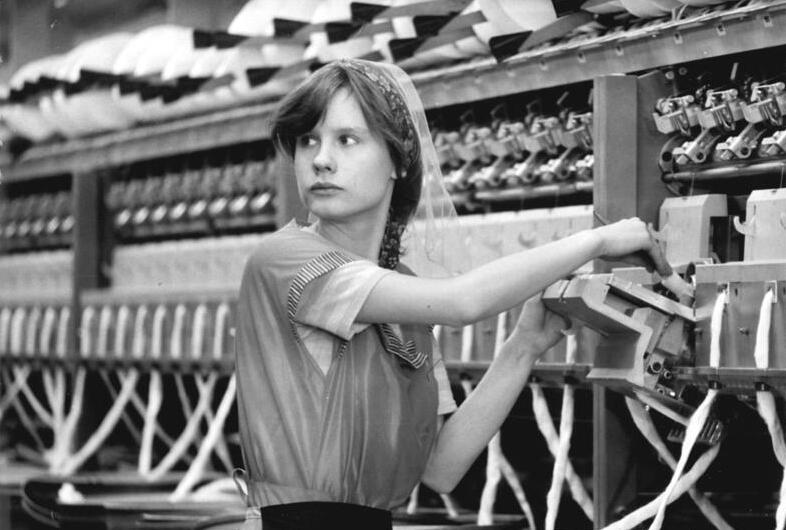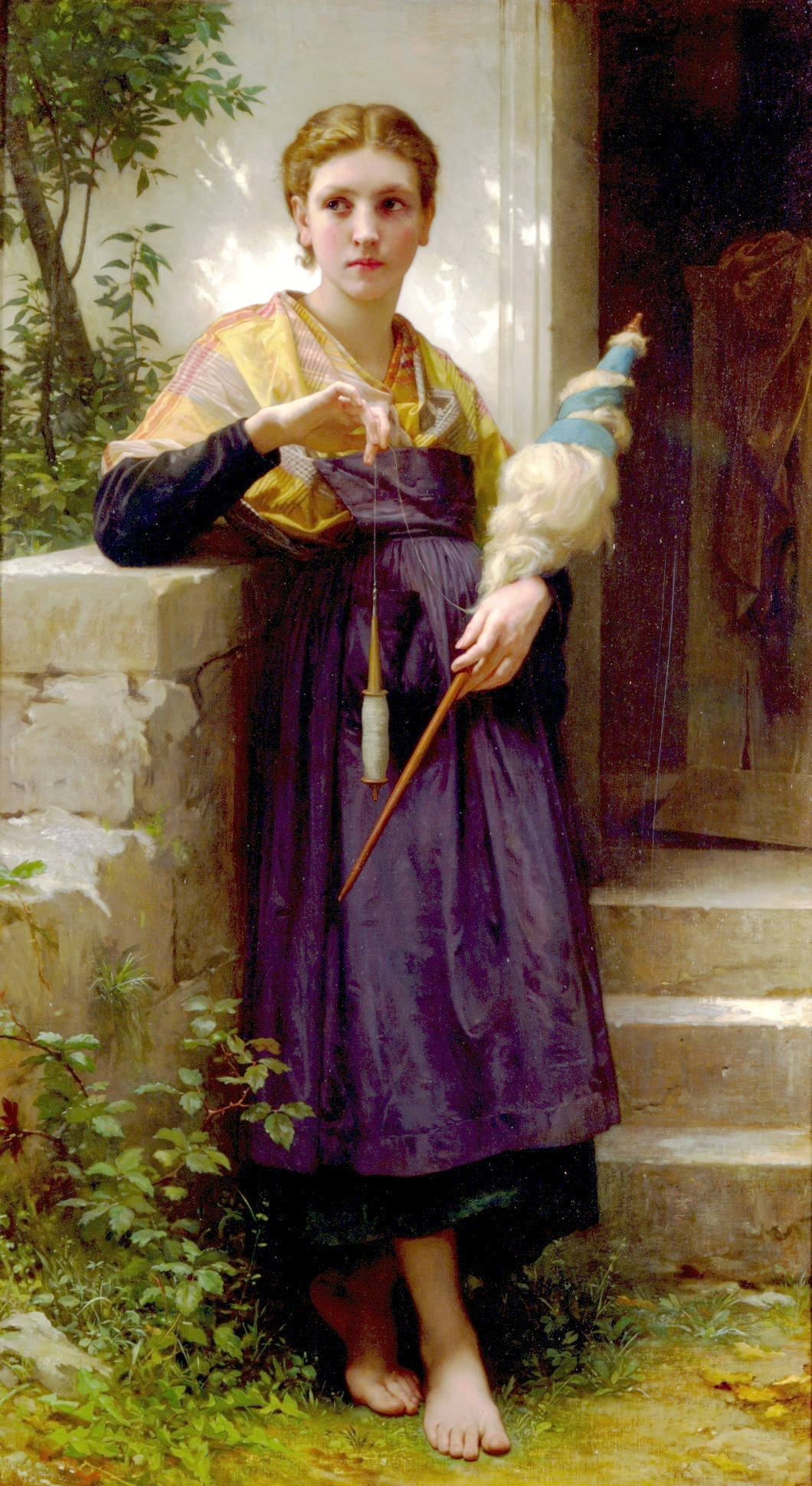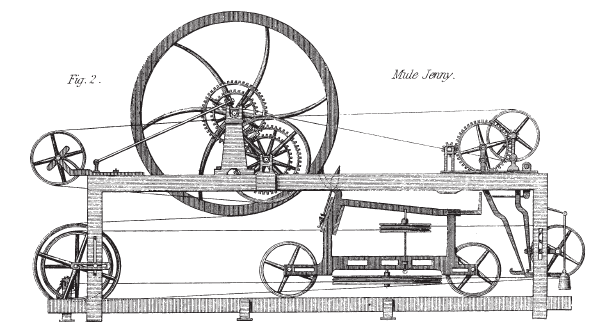|
Open-end Spinning
Open-end spinning is a technology for creating yarn without using a spindle. It was invented and developed in Czechoslovakia in Výzkumný ústav bavlnářský / Cotton Research Institute in Ústí nad Orlicí in 1963.Carl A Lawrence (2010) ''Advances in Yarn Spinning Technology'' pp. 261–273, Woodhead Publishing, Oxford Zdeněk Pospíšil (1981) ''Příručka textilního odborníka'' pp. 411–425, SNTL, Prague (Czech) Method It is also known as break spinning or rotor spinning. The principle behind open-end spinning is similar to that of a clothes dryer spinning full of sheets. If you could open the door and pull out a sheet, it would spin together as you pulled it out. Sliver from the card goes into the rotor, is spun into yarn and comes out, wrapped up on a bobbin, all ready to go to the next step. There is no roving stage or re-packaging on an auto-coner. This system is much less labour-intensive and faster than ring spinning with rotor speeds up to 140,000 rpm. The R ... [...More Info...] [...Related Items...] OR: [Wikipedia] [Google] [Baidu] |
Yarn
Yarn is a long continuous length of interlocked fibres, used in sewing, crocheting, knitting, weaving, embroidery, ropemaking, and the production of textiles. Thread is a type of yarn intended for sewing by hand or machine. Modern manufactured sewing threads may be finished with wax or other lubricants to withstand the stresses involved in sewing. Embroidery threads are yarns specifically designed for needlework. Yarn can be made of a number of natural or synthetic materials, and comes in a variety of colors and thicknesses (referred to as "weights"). Although yarn may be dyed different colours, most yarns are solid coloured with a uniform hue. Etymology The word yarn comes from Middle English, from the Old English ''gearn'', akin to Old High German ''garn'', "yarn," Dutch "garen," Italian ''chordē'', "string," and Sanskrit ''hira'', "band." History The human production of yarn is known to have existed since the Stone Age and earlier prehistory, with ancient ... [...More Info...] [...Related Items...] OR: [Wikipedia] [Google] [Baidu] |
Hand Spinning
Spinning is an ancient textile art in which plant, animal or synthetic fibres are drawn out and twisted together to form yarn. For thousands of years, fibre was spun by hand using simple tools, the spindle and distaff. It was only with the invention of the spinning wheel in the Islamic world circa 1030, and its subsequent introduction to China, India and Europe in the High Middle Ages, that the output of individual spinners dramatically increased. Mass production later arose in the 18th century with the beginnings of the Industrial Revolution. Hand-spinning remains a popular handicraft. Characteristics of spun yarn vary according to the material used, fibre length and alignment, quantity of fibre used, and degree of twist. History The origins of spinning fibre to make string or yarn are lost in time, but archaeological evidence in the form of representation of string skirts has been dated to the Upper Paleolithic era some 20,000 years ago. There has also been recent disc ... [...More Info...] [...Related Items...] OR: [Wikipedia] [Google] [Baidu] |
Units Of Textile Measurement
Textile fibers, threads, yarns and fabrics are measured in a multiplicity of units. * A fiber, a single filament of natural material, such as cotton, linen or wool, or artificial material such as nylon, polyester, metal or mineral fiber, or man-made cellulosic fibre like viscose, Modal, Lyocell or other rayon fiber is measured in terms of linear mass density, the weight of a given length of fiber. Various units are used to refer to the measurement of a fiber, such as: the denier and tex (linear mass density of fibers), super S (fineness of wool fiber), worsted count, woolen count, linen count (wet spun) (or Number English (Ne)), cotton count (or Number English (Ne)), Number metric (Nm) and yield (the reciprocal of denier and tex). * A yarn, a spun agglomeration of fibers used for knitting, weaving or sewing, is measured in terms of cotton count and yarn density. * Thread, usually consisting of multiple yarns plied together producing a long, thin strand used in sewing or w ... [...More Info...] [...Related Items...] OR: [Wikipedia] [Google] [Baidu] |
Doffing Cylinder
A doffing cylinder, also called doffing roller or commonly just doffer is a component used in textile mills to remove fiber from the main cylinder of a card, on which the fibers have been straightened and aligned. The main cylinder of the card will have one or two doffers that comb and remove the fiber. The doffer is set with pins that hold the fiber, which is then removed by a comb or knife and fed into the next stage of production. Doffers are also used in cotton pickers and other machinery that handle fiber. Confusingly, the word doffer (meaning something that takes off, as in "doff your hat") is also used for mill workers whose job it is to remove full bobbins or pirns holding spun fiber and replace them with empty bobbins or pirns. In modern mills, a machine called a doffer may do this task. Early years Some people have given credit to Richard Arkwright for inventing the doffer, which was incorporated in his machine, but others consider that it was invented by James Hargre ... [...More Info...] [...Related Items...] OR: [Wikipedia] [Google] [Baidu] |
Rieter
Rieter is a producer of textile machinery based in Winterthur, Switzerland. History Founded in 1795 by Johann Jacob Rieter (1762–1826), the company initially produced textile products. In 1806, as Napoleon imposed the Continental Blockade to prevent trade between Continental Europe and the United Kingdom The United Kingdom of Great Britain and Northern Ireland, commonly known as the United Kingdom (UK) or Britain, is a country in Europe, off the north-western coast of the continental mainland. It comprises England, Scotland, Wales and ..., it became impossible for Rieter to get spare parts for its British textile machinery. As a consequence, the company started to produce spare parts themselves, and in 1810 the first self-designed textile machine left its workshop. In 1982, Rieter acquired the British textile machinery company Ernest Scragg & Sons Ltd. The group took over Automatik (founded in 1947) in 1992. In 2011, the automotive products division, formerly R ... [...More Info...] [...Related Items...] OR: [Wikipedia] [Google] [Baidu] |
Julius Meimberg
Julius Meimberg (11 January 1917 – 17 January 2012) was a German Luftwaffe military aviator during World War II, a fighter ace credited with 53 aerial victories—that is, 53 aerial combat encounters resulting in the destruction of the enemy aircraft—claimed in over 250 combat missions. In the 1960s, he invented an open-end spinning device and received patents in the US and Germany for it. In 1970, Meimberg founded the travel agency "Meimberg" and in 2001, he received the Rudolf-Diesel-Medaille for his achievements as an inventor. Early life and career Meimberg was born on 11 January 1917 in Münster in the Province of Westphalia, a province of the Kingdom of Prussia. He was the sixth and youngest child of a textile merchant, owner of a company founded by his grandfather. World War II World War II in Europe had begun on Friday 1 September 1939 when German forces invaded Poland. On 6 December 1939, Meimberg was posted to ''Jagdgeschwader'' 2 "Richthofen" (JG 2—2nd Fi ... [...More Info...] [...Related Items...] OR: [Wikipedia] [Google] [Baidu] |
Dref Friction Spinning
Friction Spinning or Dref Spinning is a textile technology that suitable for spinning coarse counts of yarns and technical core-wrapped yarns. Dref yarns are bulky, with low tensile strength making them suitable for blankets and mop yarns, they can be spun from asbestos, carbon fibres and makes filters was water systems. Yarns such as Rayon and Kevlar can be spun using this method. The technology was developed around 1975 by Dr. Ernst Fehrer. Spinning technologies There are three current technologies used today for spinning fibres: # Roving spinning which uses the legacy ring -spinning technology of the twentieth century, # Open end, Rotor or Break Spinning used for high quality threads #Dref friction spinning for other yarns. Friction spinning is the fastest of all these techniques though the yarn is irregular and bulkier, making it suitable only for some applications. Yarn formation in friction spinning system The mechanism of yarn formation consists of three distinct ... [...More Info...] [...Related Items...] OR: [Wikipedia] [Google] [Baidu] |
Rotor Spinning
Open-end spinning is a technology for creating yarn without using a spindle. It was invented and developed in Czechoslovakia in Výzkumný ústav bavlnářský / Cotton Research Institute in Ústí nad Orlicí in 1963.Carl A Lawrence (2010) ''Advances in Yarn Spinning Technology'' pp. 261–273, Woodhead Publishing, Oxford Zdeněk Pospíšil (1981) ''Příručka textilního odborníka'' pp. 411–425, SNTL, Prague (Czech) Method It is also known as break spinning or rotor spinning. The principle behind open-end spinning is similar to that of a clothes dryer spinning full of sheets. If you could open the door and pull out a sheet, it would spin together as you pulled it out. Sliver from the card goes into the rotor, is spun into yarn and comes out, wrapped up on a bobbin, all ready to go to the next step. There is no roving stage or re-packaging on an auto-coner. This system is much less labour-intensive and faster than ring spinning with rotor speeds up to 140,000 rpm. The Ro ... [...More Info...] [...Related Items...] OR: [Wikipedia] [Google] [Baidu] |
Ring Spinning
Ring spinning is a spindle-based method of spinning fibres, such as cotton, flax or wool, to make a yarn. The ring frame developed from the throstle frame, which in its turn was a descendant of Arkwright's water frame. Ring spinning is a continuous process, unlike mule spinning which uses an intermittent action. In ring spinning, the roving is first attenuated by using drawing rollers, then spun and wound around a rotating spindle which in its turn is contained within an independently rotating ring flyer. Traditionally ring frames could only be used for the coarser counts, but they could be attended by semi-skilled labour. History Early machines * The Saxony wheel was a double band treadle spinning wheel. The spindle rotated faster than the traveller in a ratio of 8:6, drawing was done by the spinners fingers. *The water frame was developed and patented by Arkwright in the 1770s. The roving was attenuated (stretched) by draughting rollers and twisted by winding it onto a spin ... [...More Info...] [...Related Items...] OR: [Wikipedia] [Google] [Baidu] |
Mule Spinning
The spinning mule is a machine used to spin cotton and other fibres. They were used extensively from the late 18th to the early 20th century in the mills of Lancashire and elsewhere. Mules were worked in pairs by a minder, with the help of two boys: the little piecer and the big or side piecer. The carriage carried up to 1,320 spindles and could be long, and would move forward and back a distance of four times a minute. It was invented between 1775 and 1779 by Samuel Crompton. The self-acting (automatic) mule was patented by Richard Roberts in 1825. At its peak there were 50,000,000 mule spindles in Lancashire alone. Modern versions are still in niche production and are used to spin woollen yarns from noble fibres such as cashmere, ultra-fine merino and alpaca for the knitware market. The spinning mule spins textile fibres into yarn by an intermittent process. In the draw stroke, the roving is pulled through rollers and twisted; on the return it is wrapped onto the spindl ... [...More Info...] [...Related Items...] OR: [Wikipedia] [Google] [Baidu] |
Maple Mill, Oldham
The Maple Mill was a cotton spinning mill in Hathershaw, Oldham, Greater Manchester, England. It was designed as a double mill by the architect Sydney Stott. The first mill was built in 1904 and the second mill in 1915. In 1968, it was equipped with the first open-end spinning machines in England. When spinning ceased in the 1990s, it was bought by Vance Miller. Trading Standards raided the mill in 2006, and ordered Mr Miller stop selling products that failed national safety provisions. Maple No.2 was mostly destroyed by fire in April 2009; the fire brigade was in attendance for two weeks and deployed 34 appliances. Maple No.1 was damaged by fire on 30 September 2016. On 15 December 2016 a major incident was declared when the same mill became fully ablaze. Architecture Maple Mill was a double mill. Maple No.2 was designed by P.S.Stott, so the round chimney carried the double rings that were his trademark. This was a six-storey red brick mill built in 1904. Stott did not us ... [...More Info...] [...Related Items...] OR: [Wikipedia] [Google] [Baidu] |
Spindle (textiles)
A spindle is a straight spike usually made from wood used for spinning, twisting fibers such as wool, flax, hemp, cotton into yarn. It is often weighted at either the bottom, middle, or top, commonly by a disc or spherical object called a whorl; many spindles, however, are weighted simply by thickening their shape towards the bottom, e.g. Orenburg and French spindles. The spindle may also have a hook, groove, or notch at the top to guide the yarn. Spindles come in many different sizes and weights depending on the thickness of the yarn one desires to spin. History The origin of the first wooden spindle is lost to history because the materials did not survive. Whorl-weighted spindles date back at least to Neolithic times; spindle whorls have been found in archaeological digs around the world. A spindle is also part of traditional spinning wheels where it is horizontal, such as the Indian charkha and the great or walking wheel. In industrial yarn production, spindles are used a ... [...More Info...] [...Related Items...] OR: [Wikipedia] [Google] [Baidu] |







.jpg)
